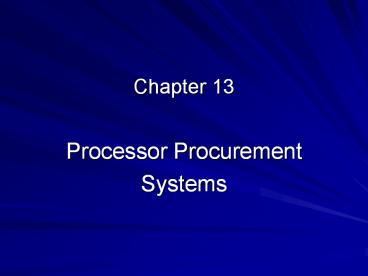Processor Procurement - PowerPoint PPT Presentation
1 / 18
Title:
Processor Procurement
Description:
Bargaining cooperatives. Marketing-Procurement. Alternatives ... Bargaining Cooperative. Processor bargains with cooperative over price and quantity ... – PowerPoint PPT presentation
Number of Views:31
Avg rating:3.0/5.0
Title: Processor Procurement
1
Chapter 13
- Processor Procurement
- Systems
2
Processor as Coordinator
- Goal to keep organization running with
flow-through that is profitable - Profitable operation requires careful management
of volume and margin - Adequate volume Costs are minimized when a firm
and its plants operate at nearly full capacity - Processors margin what he obtains for his
services
3
Procurement Systems
- Management decision Make or buy
- Classification of systems
- Spot (current cash) market
- Procurement contracts
- Production contracts
- Labor contracts
- Bargaining cooperatives
4
Marketing-ProcurementAlternatives
5
Procurement in the Spot(Current Cash) Market
- Processor achieves advantage by better timing of
purchases, anticipating when farmers are anxious
to sell - Requires monitoring of both private and public
sources of market intelligence
6
Procurement Contracts
- Reduce both flexibility and uncertainties
- May give processor outs in case of strikes,
acts of God and so forth - May allow for price discounts or even refusal of
delivery if commodity quality does not meet
contract specifications - May or may not fix price
7
Procurement byProduction Contract
- Agreement between two business entities to
produce a good - Put processor in the business of production
- Processors select producers largely based on
geographical location
8
Procurement byLabor Contract
- Agreement between employer and employee to carry
out specific tasks - Processor is producer assumes production risks
as well as profits and losses - Production in ones own facilities by ones own
employees, representing complete vertical
integration
9
Procurement from aBargaining Cooperative
- Processor bargains with cooperative over price
and quantity - Prices paid by all processors likely to be the
same - Processors may feel cooperative hinders
communication with individual producers - Producers favor cooperatives because of quantity
sales, higher prices, and more efficient market
timing
10
Livestock Procurement
- Most livestock procured through non-cash methods
- Decisions of packer in organizing total
procurement based on several factors - How hard is operation relative to nearby
competitors? - Are his purchases large enough to affect market
price? - To what extent are supplies available through
other producers? - and so on
11
Pork Procurement
- Methods have evolved rapidly
- Focus on economies of size motivated rapid
expansion, management efficiencies, use of
production contracts - Processors have integrated vertically
12
Percentage of HogsSold on Cash Market
13
Cattle Procurement
- System involves a staff of cattle buyers
- Packers maintain excellent communication system
to keep buyers informed - Market information published as Yellow Sheet and
Meat Sheet and by AMS division of USDA - Packers buy on carcass grade and yield
14
Percentage of Cattle SoldThrough Non-Cash Market
15
Vegetable Procurement
- Value to be attributed to raw product depends on
market factors that are difficult to anticipate - Vegetable processor makes annual price
determination - Little direct competition in negotiation of
contracts processor typically procures within
50-mile radius of plant - Processor buys on grade and yield
16
Wheat, Corn, SoybeanProcurement
- Grain and soybean channels have considerable
vertical integration - Limited organization of processors
- Inventory management
- On-track buying
- Back-to-back trading
- Use of basis pricing and basis trading
- Consider convenience yield in determining
inventories
17
Grain M-P Channelsand Pricing Points
18
Class Exercise
- Using your assigned commodity, interview a
procurement person for one of the agribusinesses
that buy the commodity. Suggested questions - What methods (cash, contract, broker) are used to
buy the commodity? - What logistical issues arise?
- Is quality an issue in the buying decision?
- What does a typical business day involve?































